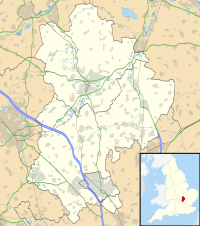St Denys' Church, Little Barford
| St Denys' Church, Little Barford | |
|---|---|

St Denys' Church, Little Barford, from the south with the site of the deserted medieval village in the foreground
|
|
| Coordinates: 52°11′54″N 0°16′43″W / 52.1982°N 0.2785°W | |
| OS grid reference | TL 178 569 |
| Location | Little Barford, Bedfordshire |
| Country | England |
| Denomination | Anglican |
| Website | Churches Conservation Trust |
| History | |
| Dedication | Saint Denys |
| Architecture | |
| Functional status | Redundant |
| Heritage designation | Grade II* |
| Designated | 13 July 1964 |
| Architect(s) | Arthur Blomfield (restoration) |
| Architectural type | Church |
| Style | Norman, Gothic, Gothic Revival |
| Specifications | |
| Materials |
Cobbles with ashlar dressings Roofs tiled or slated |
St Denys' Church is a redundant Anglican church in the village of Little Barford, Bedfordshire, England. It is recorded in the National Heritage List for England as a designated Grade II* listed building, and is under the care of the Churches Conservation Trust. The church lies to the west of the village of Little Barford, overlooking the River Great Ouse, about 2 miles (3 km) south of St Neots.
The oldest fabric in the church is in the nave and the chancel and dates from the Norman era. Alterations and additions took place in the 14th, 15th and 19th centuries. The tower was built in the late 15th century and the clerestory was added in the same century. In 1834 a south chapel was demolished and it was replaced in 1869 by a vestry and organ chamber. This was part of a restoration carried out by Arthur Blomfield. The church closed in 1972, and two years later was vested in the Redundant Churches Fund (the forerunner of the Churches Conservation Trust). The church had been built to serve a medieval village which has since been deserted.
The church is constructed in cobbles with ashlar dressings. Some roofs are tiled, others are slated. The plan consists of a nave with a clerestory and a north aisle, a chancel with a south vestry, and a west tower. The tower is in three stages with an embattled parapet, paired bell openings, and a five-light west window. The east window in the chancel consists of three lancets, and in the north wall of the chancel are two windows in 14th-century style. In the south wall of the nave are three windows; one at a higher level dates from the 16th century, the others are from the 19th century, one in 12th-century style, and the other in the style of the 14th century. The south doorway dates from the 12th century. It has a semicircular arch, is decorated with zigzag and dogtooth designs, and has scalloped capitals. To the east of the doorway is a projecting stone for holding holy water. The clerestory has two windows on each side and a plain parapet. In the north wall of the aisle are re-set 12th-century windows, and windows dating from the 19th century.
...
Wikipedia

